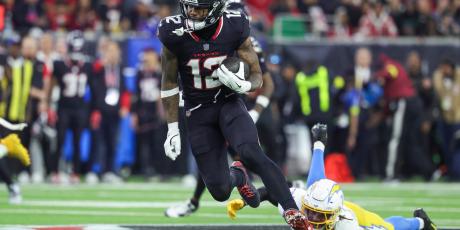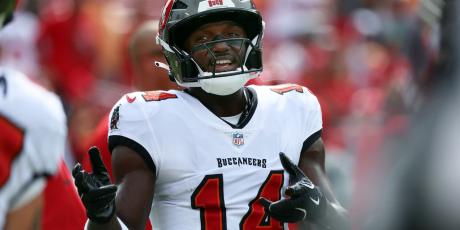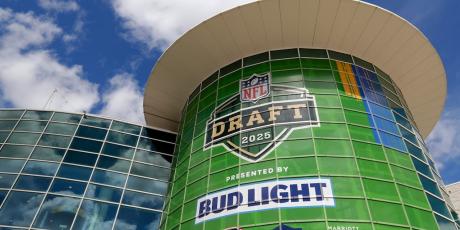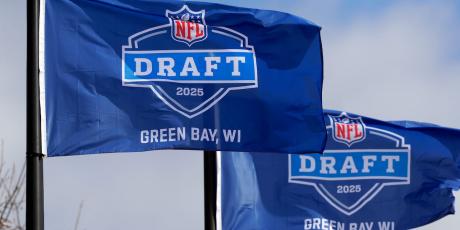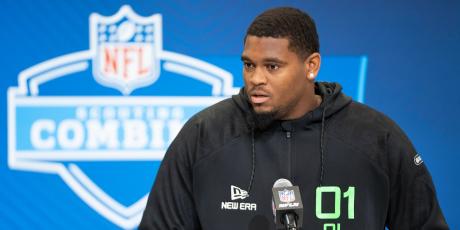Yes, You Should be Using Zero RB in 2016

The False Sense of Security of Drafting RBs Early
I’m going to go out on a limb and assume most of you have never heard the phrase “being up 2-0 is the worst lead in hockey”. I’ll use it anyway, because I like hockey, and this is my article. Sure, I suppose in a roundabout way, it’s also slightly (okay, very) relevant to fantasy football as well.
You may figure that any lead would be a good lead. Not the case. There are many reasons why a 2-0 lead is the worst type of lead you can have. I’ve personally been on both sides of it and let me tell you from experience, it’s a real thing.
With a 2-0 lead, some players and coaches begin to behave differently. We're playing to protect the lead. We begin to play in fear.
More often than not, when you play in fear the opposition will score, the momentum shifts the other team’s way very quickly.
You begin to feel like it is only a matter of time before the opponent scores again. If you allow this energy shift to occur in your head, it's already over. Players begin to over think their game and some teams never recover.
There is a clear parallel between playing with a 2-0 lead in a hockey game and attacking the RB position early in fantasy drafts.
Most leagues are filled with fantasy owners that try to acquire two RBs in the first four rounds. These owners feel they have an early lead, so to speak, when they draft two or three elite rushers -- but all they really have is a false sense of security at football’s most fragile position!
Then there's the fact that many drafters are aware of the risks involved at the RB position and draft handcuffs. And if they don't draft handcuffs, they at least acknowledge the need for more viable options behind these studs later in the draft. One way or another, they end up spending the rest of their draft protecting their perceived lead at RB through fear.
Meanwhile, sharp drafters are subtly overtaking the RB hoarders by loading up on assets that shore up their weaknesses without diminishing their strengths.
Drafting RBs early is the comfortable and conventional approach in many of your home leagues, but that doesn't mean it's a winning strategy.
“Once a process becomes conventional it’s often the safest path to mediocrity.” - Matt Waldman
Sure, plenty of hockey teams that go up 2-0 actually win the game. The difference is they don’t sit back and hope, they step on their opponent’s throat. The best way to do this in fantasy football is to draft in a way that actually gives your team a chance to improve throughout the season. It’s called contingency-based drafting, where you build in as much flexibility and options you can while also building in as much upside as possible. In essence, it's the Zero RB draft strategy.
What does it mean to go Zero RB? That sounds crazy.
All the credit goes to Shawn Siegele over at RotoViz for popularizing this strategy a few years back, but Zero RB is quite simply a contrarian way to draft if your league typically goes RB-heavy in the early rounds. It allows you to take advantage of overzealous RB drafters by stockpiling high-upside WRs while setting your team up to improve while your competitors' teams decline as the season wears on.
This strategy works particularly well in Point Per Reception (PPR) leagues, but can also be very effective in non-PPR.
My colleague here at 4for4, John Paulson, published a great piece last year entitled Are Early Round Receivers Safer Than Running Backs?
Spoiler alert: they are.
Not only are WRs safer than RBs, but by eschewing RBs in the early rounds to draft WRs, you're positioning your team to be overwhelmingly strong at fantasy's highest-scoring position; a position which often requires you to fill the most roster slots.
Excluding QB, nine WRs and just one RB finished top-10 overall in PPR leagues in 2015. Even in standard leagues, WR still had the edge, six to four.
RELATED: Auction Draft Strategy: Tips & Tricks and How to Approach 2016 Drafts
League-winning RBs are Rarely Predicted in the Preseason
The biggest obstacle you will have to get over while using the Zero RB strategy for the first time is removing from your mind subconscious (or conscious) biases from years past. Everyone knows how well this years top RBs performed in 2015 or the great situation a few have just stepped into (I’m talking about you, Zeke).
The reality is that no matter how positive we are about our RB rankings in June, league-winning RBs are rarely who we think they are going to be.
Devonta Freeman wasn’t even the first back drafted from Atlanta last year. Instead, Freeman was an 11th- or 12th-round pick that ended up being fantasy’s number-one player in 2015. Freeman was a lottery ticket at best, but one that many Zero RB drafters fell into after loading up at WR early.
This is the kind of thing that will help you win your league.
According to average draft position (ADP), Adrian Peterson was the only top-10 RB in PPR leagues to actually finish the 2015 season ranked top-10 at the position.
That said, 2015 may be a drastic example, as the apocalypse at the RB position will likely prove to be somewhat of an outlier. At 4.6 per year, the average number of RBs to maintain top-10 value at the position since 2010 is much better. Still, less than half of RBs drafted in the top-10 in the last five years repaid drafters with actual top-10 value.
A Smarter Approach: Going Antifragile with Contingency-Based Drafting
Whether you decide to exercise the Zero RB strategy or not, you should always try and build in as much flexibility as you can and as much upside as possible. Zero RB just happens to be the best way to do this.
Contingency-based drafting is all about profiting from the chaos of the RB position. As the season goes on the landscape can change very quickly, whether it be due to injuries, depth chart changes, unexpected breakouts, or something else.
You can actually draft in a way that profits from this chaos and sets your team up to get better.
Former day trader and current author Nassim Taleb has coined a phrase for something that profits from chaos: antifragility. He points out that the opposite of fragility -- being hurt by chaos -- isn't actually resiliency, because things that are resilient may withstand chaos, but don't necessarily gain from it. Something that is antifragile not only stands up to chaos, it benefits from it.
You want your fantasy team to benefit from injuries and other inevitable uncertainties that will occur during the season.
You want your team to be antifragile.
Zero RB is antifragile.
Before I get into the positives of an antifragile roster, let me make one thing clear: you should never be rooting for injuries. These are real people, with real lives, and real families to support.
Factually, however, you know the reality of professional sports is that people will get hurt. A better way to think about it is other players are getting opportunities they may not otherwise have gotten. As fans, we get to see great performances from backups and depth players we never would have been able to enjoy otherwise. The point is you need to have a fantasy roster that is built in such a way that when random things happen, your team doesn’t struggle -- it actually gets better.
Zero RB allows you to benefit from randomness as opposed to being a victim of it. There are a lot of unnecessary pressures people put on themselves by taking RBs in the early rounds. RBs touch the ball more than WRs, and therefore get injured more. They also are more interchangeable, because a lot of their success depends on the offensive line.
But when your 11th-round flier tears his ACL, or is otherwise not performing well, it doesn’t hurt nearly as bad. For fantasy purposes, who cares? He was your 11th-round pick; a competent fantasy owner should have no problem recovering from that. To me, a bust is a player you have invested a highly important draft pick in and one that performs far worse that where you took him. I have a hard time considering any late-round player a bust.
Under Zero RB, when an elite RB gets hurt or underperforms, your lineup can get better in a few ways.
First off, your opponents’ player is out, yours isn’t.
Second, your team gets better because you either already have the other RB in the committee or you have a shot at acquiring the backup on the waiver wire.
Zero RB teams are very antifragile, and that's a huge positive. Early round RB teams are merely resilient, at best. Antifragile rosters, however, are able to overcome the resiliency of early round RB rosters. Early RB teams will inherently tend to have weaker WRs, so they will need to deploy a RB in the FLEX more often. Beyond the fact that in this day and age, most WRs will outscore RBs at similar ADP, there's also the fact that as a result of going with RBs early, early RB drafters will tend to see their team suffer from a lack of depth and upside. They'll always fear that their stud RB will go down. This causes them to forgo a lot of league-winning upside by preparing RB contingency plans throughout the draft.
RELATED: 5 Reasons to Draft T.Y. Hilton over Jordy Nelson
What Types of RBs to Target for Zero RB
It is no secret that the NFL is turning into more of a passing league. You probably know that rushing is not as efficient as passing on a pure per-attempt basis -- that is, a passing play averages more yardage than a rushing play.
This doesn’t mean running the ball is useless; it is imperative in real football. However, gaining smaller chunks of yardage at a time is not efficient in fantasy football, either.
Fantasy football is still about discovering what players, and what types of players, will give you the most points.
Targeting RBs who catch a lot of passes is ideal. With spread offenses becoming more and more common, a RB who can catch passes out of the backfield and make plays in space is becoming more and more valuable every year. Backs like Danny Woodhead, Theo Riddick, and Dion Lewis that can line up all over the place give teams in today’s NFL a huge advantage. Teams love to employ spread offenses, but rarely put five WRs on the field; when they go with empty backfield, it's often that a RB will line up out wide. It's no surprise that Woodhead, Riddick, and Sims all went overlooked in drafts but all finished as top-20 PPR RBs.
Beyond pass-catching skills, there are a few other reasons RBs going in the middle-to-late rounds will be undervalued. Since you're not investing a lot of draft capital in these RBs, any RB slated to see significant volume should be considered. There is almost always a breaking point where they become values, regardless of what you think of their talent.
Also, any RB that will run behind a strong offensive line is in play, even if, again, you're not crazy about the RB's actual talent. After languishing in Oakland for years, Darren McFadden turned in a ranking of PPR RB13 last season, and he wasn't even the starter for the entire 16 games.
It might be obvious, but one of the biggest components to being successful when using Zero RB is working the waiver wire tirelessly during the season. Waiting on RB can be ultimately end up as an ineffective endeavor if you fail at this task. You still have to be able to uncover a starter at some point due to an injury or breakout performance, and you can't always count on your middle- and late-round draft shots at RB to hit.
RELATED: How to Not Lose Your Fantasy Football League in the First Round
Things to Consider Before Using Zero RB in 2016
The philosophy behind the Zero RB draft strategy is essentially to avoid the norm and take a contrarian approach. Once something becomes the norm, it is often no longer the most effective approach.
If the RB position becomes diluted to the point where your opportunity to land the best players is waning, then you have to adjust accordingly and not allow yourself to be prevented from capitalizing on available top talent at other positions in the early rounds just to draft mediocre RBs.
Of course, the worry for the Zero RB approach is that the fantasy community tends to overcorrect each year. Taking into consideration how historically bad the RB position was in 2015, it is reasonable to believe that more people will employ the Zero RB strategy in 2016 than ever before.
However, even if more people use Zero RB this year, the strategy is still viable. Essentially it becomes you versus a few others instead of you versus none. Either way, RBs will still go too early and other favorable players will still drop.
Just two seasons ago, things were quite different from 2015. Four of the top five fantasy RBs finished as top-15 options at the position and all of them were drafted in the 1-15 range. This is part of the reason a lot of people went RB crazy in the first round in 2015.
Another example was 2011, when we saw a historically high numbers from the QB position. The next season, five QBs were invariably gone after the second round of drafts. That was clearly is an overcorrection as well, and most drafters now know the surplus at the QB position means drafting a late rounder is optimal.
In no way am I trying to scare you off of Zero RB; I just think it's fair to explore both the positives and negatives of any strategy. But I cannot stress enough that every draft is different and if you go into it with a set strategy and are unwilling to adjust in real time, you can open yourself up to the mediocrity of the norm.
RELATED: 2016 Fantasy Football Draft Kit
How to Attack the RB Position in 2016
Now that I’ve stressed the importance of not being locked into one philosophy, here goes my plan for the RB position in 2016.
Situation permitting, I strongly believe in the Zero RB approach, especially in PPR formats.
The goal is to load up on elite pass catchers early, and lots of them. Ideally, I want four big-time WRs on my roster to fill all WR spots and the FLEX position through six rounds.
It would take something pretty outrageous early to deter me from starting, at minimum, WR-WR-WR in PPR leagues. Having too many players at a position that is most important is more of a luxury than a problem.
With that said, the only thing that keeps me from going with four straight WRs is if I can grab either Dion Lewis or C.J. Anderson at their current fourth round ADP. If that happens, I'm doing cartwheels and feeling great about my WR and RB1 situation.
If both Lewis and Anderson are gone, I have no problem grabbing a guy like Donte Moncrief, who can consistently be had in the fourth round (as of this writing).
From there I am most likely waiting until at least the sixth round to grab a RB, quietly collecting assets at other positions. I find myself grabbing Duke Johnson or Giovani Bernard more often than not in this range. What can I say, I'm a sucker for pass-catching talent and upside.
After that, there is a ton of value at RB in the 8th to 14th round. Young pass-catching backs like Charles Sims and C.J. Prosise should be factors for their respective teams. Proven veterans just one injury away like DeAngelo Williams or LeGarrette Blount could easily be league winners. In deeper leagues, backs like C.J. Spiller and Spencer Ware could be high-upside fliers.
The inevitable turnover at the RB position allows for these mid-to-late-round RBs to emerge as the season wears on, so I’m fine with digging deep for production and playing matchups early on while enjoying a reliable workload from my stud WRs.
Each year, my draft plan is heavily dependent on the value I see materializing in the upcoming season. It’s very important to evaluate the fantasy landscape as a whole each year while preparing for drafts. After seeing the advantages in the Zero RB theory, I am now more convinced than ever that going all in on the elite options at WR early in fantasy drafts is the right move.
I see Zero RB as the ideal strategy for fantasy drafts in 2016.
Editor's Note: Don't miss out on early bird rates for 4for4's Premium and DFS Subscriptions.

